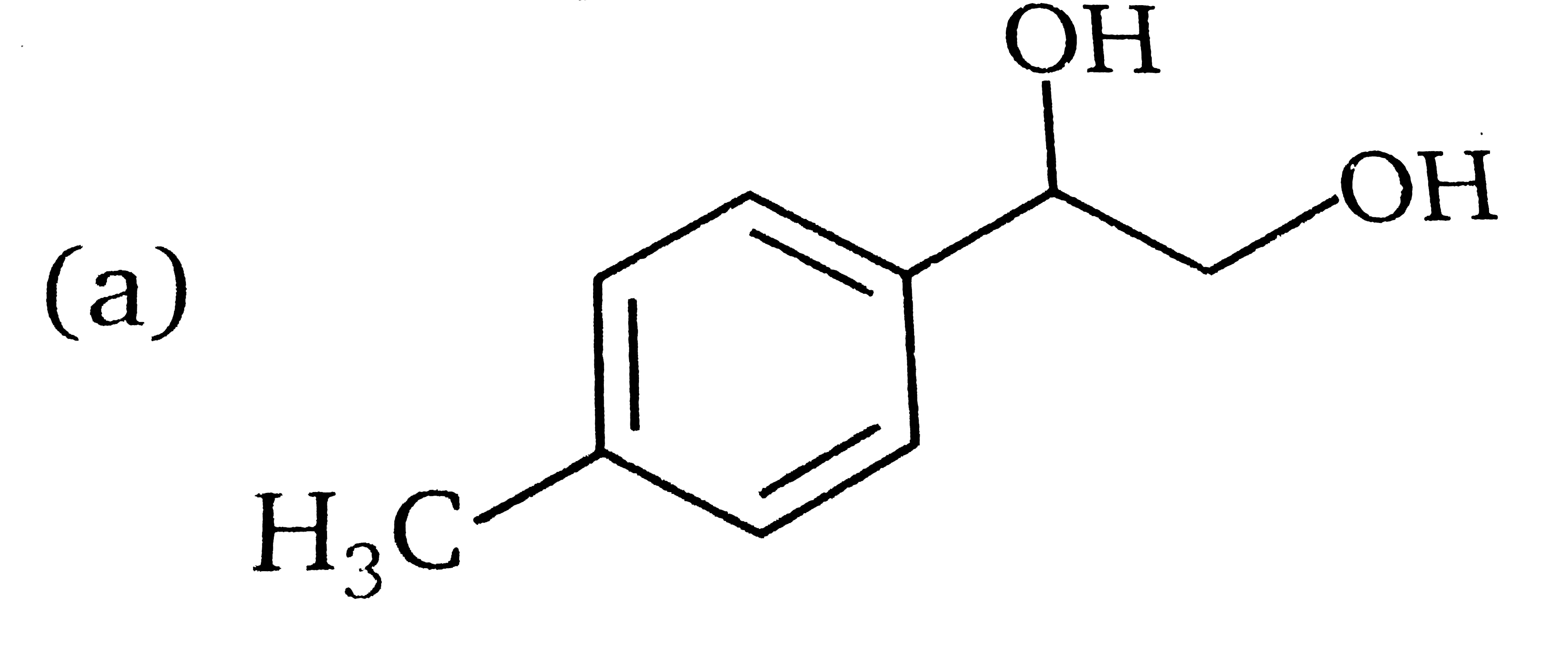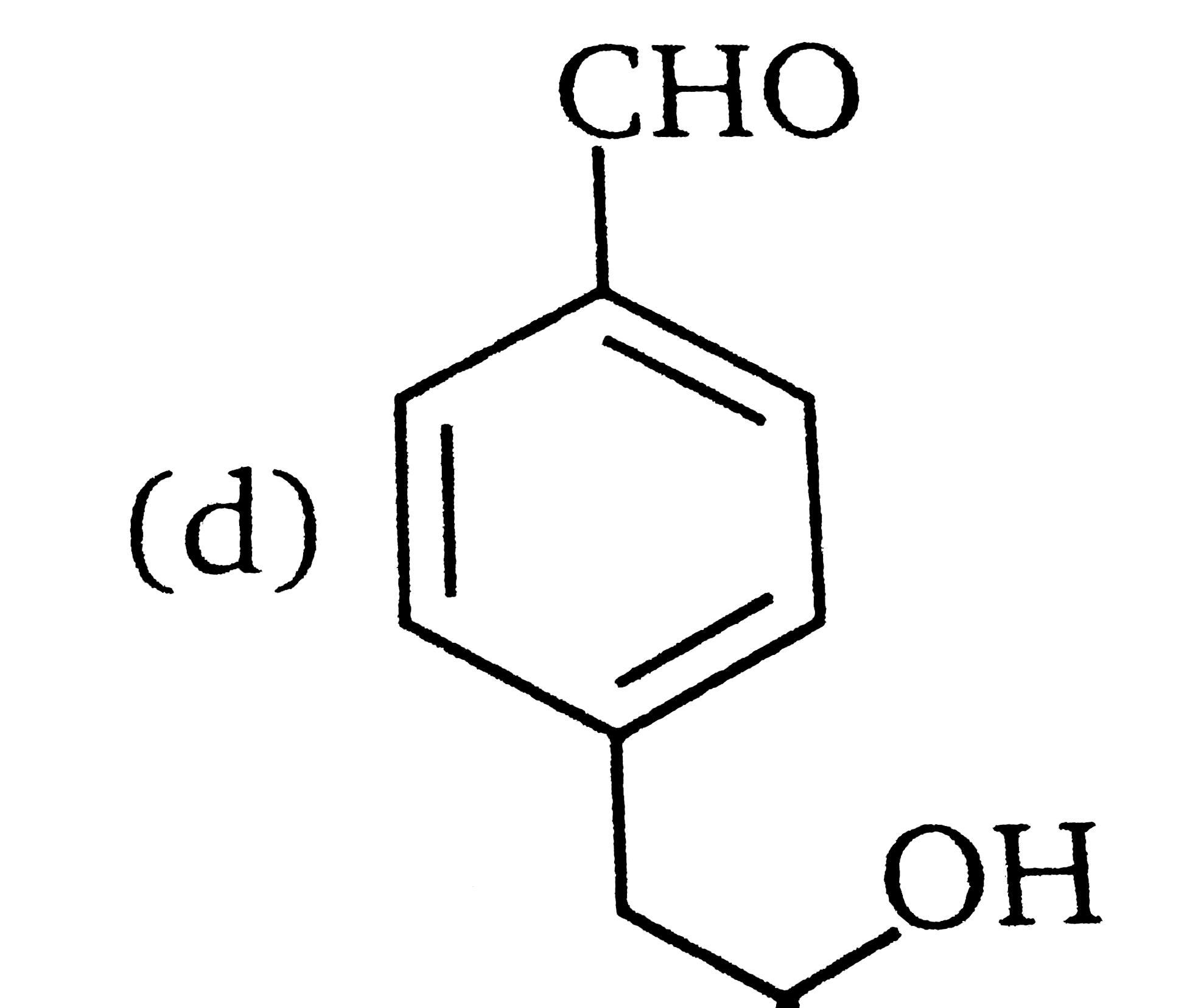The reaction of 50% aq KOH on an equimolar mixture of 4-methylbenzaldehyde and formaldehyde followed by acidification gives.




The correct Answer is:B
To solve the problem, we need to analyze the reaction between 4-methylbenzaldehyde and formaldehyde when treated with 50% aqueous KOH followed by acidification.
1. Identify the Reactants:
- We have 4-methylbenzaldehyde (C6H5CHO) and formaldehyde (HCHO) in an equimolar mixture.
- Structure of 4-methylbenzaldehyde: It has a benzene ring with a formyl group (CHO) and a methyl group (CH3) at the para position.
2. Reaction with 50% Aqueous KOH:
- The reaction with KOH suggests that we are performing a condensation reaction, specifically a benzoin condensation or similar reaction.
- Under basic conditions, the aldehyde groups can undergo nucleophilic addition.
3. Formation of the Product:
- The 4-methylbenzaldehyde will react with formaldehyde. The aldehyde group of formaldehyde can act as a nucleophile and attack the carbonyl carbon of 4-methylbenzaldehyde.
- The reaction leads to the formation of a new compound where the carbonyl group (C=O) of 4-methylbenzaldehyde is converted to a hydroxyl group (C-OH), resulting in a secondary alcohol.
4. Acidification:
- After the reaction with KOH, the mixture is acidified. Acidification will protonate the hydroxyl group, stabilizing the product.
- The final product after acidification will be a hydroxy compound derived from the original aldehydes.
5. Final Product:
- The final product of this reaction is 4-methylbenzyl alcohol (C6H5CH(OH)CH3) and formic acid (HCOOH) from the formaldehyde.
- Thus, the overall reaction yields 4-methylbenzyl alcohol and formic acid.
Conclusion:
The reaction of 50% aqueous KOH on an equimolar mixture of 4-methylbenzaldehyde and formaldehyde followed by acidification gives 4-methylbenzyl alcohol and formic acid.
- We have 4-methylbenzaldehyde (C6H5CHO) and formaldehyde (HCHO) in an equimolar mixture.
- Structure of 4-methylbenzaldehyde: It has a benzene ring with a formyl group (CHO) and a methyl group (CH3) at the para position.
- The reaction with KOH suggests that we are performing a condensation reaction, specifically a benzoin condensation or similar reaction.
- Under basic conditions, the aldehyde groups can undergo nucleophilic addition.
- The 4-methylbenzaldehyde will react with formaldehyde. The aldehyde group of formaldehyde can act as a nucleophile and attack the carbonyl carbon of 4-methylbenzaldehyde.
- The reaction leads to the formation of a new compound where the carbonyl group (C=O) of 4-methylbenzaldehyde is converted to a hydroxyl group (C-OH), resulting in a secondary alcohol.
- After the reaction with KOH, the mixture is acidified. Acidification will protonate the hydroxyl group, stabilizing the product.
- The final product after acidification will be a hydroxy compound derived from the original aldehydes.
- The final product of this reaction is 4-methylbenzyl alcohol (C6H5CH(OH)CH3) and formic acid (HCOOH) from the formaldehyde.
- Thus, the overall reaction yields 4-methylbenzyl alcohol and formic acid.
The reaction of 50% aqueous KOH on an equimolar mixture of 4-methylbenzaldehyde and formaldehyde followed by acidification gives 4-methylbenzyl alcohol and formic acid.
Topper's Solved these Questions
- AROMATIC COMPOUNDSBOOK - MS CHOUHANCHAPTER - AROMATIC COMPOUNDSEXERCISE - Level 1 (Q.31 To Q.60)
1 Videos
- AROMATIC COMPOUNDSBOOK - MS CHOUHANCHAPTER - AROMATIC COMPOUNDSEXERCISE - Level 1 (Q.121 To Q.150)
3 Videos
- AN INTRODUCTION TO ORGANIC REACTIONS AND THEIR MECHANISMS ACIDS AND BASESBOOK - MS CHOUHANCHAPTER - AN INTRODUCTION TO ORGANIC REACTIONS AND THEIR MECHANISMS ACIDS AND BASESEXERCISE - ADDITIONAL QUESTION (SINGLE CORRECT CHOICE TYPE )
32 Videos
- BIOMOLECULESBOOK - MS CHOUHANCHAPTER - BIOMOLECULESEXERCISE - Level 2
1 Videos
Similar Questions
Knowledge Check
A mixture of benzaldehyde and formaldehyde when treated with 50% NaOH yields
Asodium benzoate and sodium formateBsodium formate and benzyl alcoholCsodium benzoate and methyl alcoholDbenzyl alcohol and methyl alcoholA mixture of benzaldehyde and formaldehyde when treated with 50% NaOH yields
Asodium benzoate and sodium formateBsodium formate and benzyl alcoholCsodium benzoate and methyl alcoholDbenzyl alcohol and methyl alcoholA mixture of benzaldehyde and formaldehyde when treated with 50% NaOH yields.
ASodium benzoate and sodium formateBSodium formate and benzyl alcoholCSodium benzoate and methyl alcoholDBenzyl alcohol and methyl alcohol
On hydrolysis sucrose gives equimolar mixture of
View Solutionα-chloropropanoic acid on treatment with alcoholic acid KOH followed by acidification gives :
View SolutionReaction of formaldehyde and ammonia gives
View SolutionAcid or enzymatic hydrolysis of sucrose to give an equimolar mixture of glucose and fructose is called
View SolutionIn Nef-Carbonyl synthesis, primary nitroalkanes treatment with NaOH followed by acidification with 50%, H2SO4 gives:
View Solution
